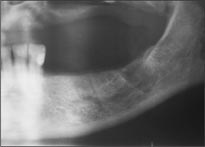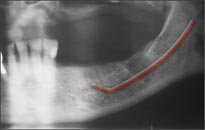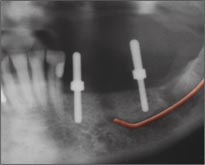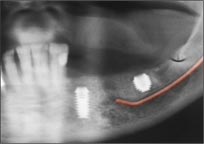Articles
|
“I have been placing Bicon implants since 1997, and love their simplicity and reliability. I’ve been using Bicon SHORT® Implants since they first came out in the UK. Although I am experienced in all types of bone grafting for dental implants, Bicon SHORT® Implants frequently allow my patients to avoid the need for any grafting at all. I have to worry less and less about sinuses and nerves as SHORT® Implants allow me to stay well away from them—patient acceptance for implant treatment soars when you don’t have to tell them about bone grafts!” Dr. Bill Schaeffer, Oral Surgeon London, UK |
Bicon SHORT® Implantsby Dr. Bill Schaeffer In our daily practices, as dental professionals we are often confronted with patients who meet the ideal criteria for implant treatment, but have shallow bone. Your patients may have missing teeth, knowledge about dental implants, desire for a permanent solution, and the financial means to afford implant treatment, but the one key factor that they often lack is sufficient bone height for longer implants. Bone grafting may partially solve the issue, but bone grafting can be expensive, is time-consuming, involves inherent risks and is always uncomfortable for the patient. In my experience, and in my practice, SHORT® Implants provide an excellent alternative to bone grafting and can allow patients to more easily enjoy the benefits of implant treatment. Anatomical Considerations In placing longer implants, there are two major areas for anatomical concern when faced with shallow bone height. In the maxilla, the maxillary sinus can pose a hazard when placing longer implants. Driving an implant through the sinus floor and into the sinus may not be a medical emergency, but if you’ve not planned to do it, it can sure ruin your day! It can also require extended explanations and assurances to calm a concerned patient. In the mandible the inferior alveolar nerve poses a much more serious risk. Parasthesia is a real danger to your patient if the alveolar nerve is damaged when placing a longer implant. As a result, an associated lawsuit could be damaging to your practice and livelihood. Parasthesia and Lawsuits Parasthesia. The mention of the word can chill a dental professional’s blood, and lately, it has become a favorite lawsuit with jury awards upwards of $350,000. We should not spend our professional lives in constant fear of negative outcomes and runaway lawsuits, but solid business sense (as well as plain common sense), says that we should always manage our risks. “Why not just graft?” I love grafting (well, I am a surgeon after all), but I’m very aware that my patients don’t enjoy it nearly as much as I do. It may seem sensible to graft every patient with shallow bone, but grafts can be expensive and often require extended periods for healing. Patients may not want to pay for grafts or wait 6-8 months for a graft to heal. In addition, bone graft procedures have risks involved, are surgically invasive and are extremely technique sensitive. Grafts are not a simple solution and patients don’t like them. You will be amazed at how your case acceptance will soar when you don’t have to mention bone grafting to your patients. A Simple Solution: Bicon SHORT® Implants Short implants can provide an easy and simple solution and allow your patients to enjoy the benefits of implant treatment. Bicon’s SHORT® Implants are available in lengths as short as 5.7mm and uniquely offer a massive surface area, thanks to their innovative finned design. The fins and plateaus of the Bicon design provide at least 30% more surface area than a screw design of a similar length and width. These fins and plateaus distribute the forces of occlusion evenly over the implant surface. In addition, the Bicon design promotes mature haversian bone around the implant, and in and around the fins. Contrary to the appositional bone found around screw-designed implants, this haversian bone offers unique clinical capabilities. One of those capabilities is increased crown-implant ratios. You would be amazed at what these little implants can do! “But they look so weird! How can they possibly work?” The Bicon SHORT® Implants do appear strange at first and the large crown-root ratios go against what we are conventionally taught for teeth. But these implants do work—and they work really, really well even in the most challenging situations of limited bone. Implants are not like teeth in that they do not have a periodontal ligament and instead they are ankylosed to the bone. The conventional rules about crown-root ratios simply do not apply to dental implants. “Prove it!” The Bicon SHORT® Implants have been clinically researched since 1997, and were introduced in 2002. According to Gentile, Chuang, and Dodson, IJOMI November/December 2005, Bicon SHORT® Implants “can be a clinically acceptable option to facilitate prosthetic restoration where alveolar bone height is limited or anatomic limitations exist.” Since their introduction, Bicon’s SHORT® Implants have enjoyed tremendous success. But I’m not an academic and even more impressive to me are the cases after cases that they have on the Bicon website showing the incredible bone levels around these SHORT® Implants after more than 7 years in function as unsplinted single molar units. You have to see it to believe it! Treatment Planning and Keys to Success When placing implants into limited areas of bone it is vital to know how much bone you have to work with. X-rays before you start the case are of course mandatory, but I strongly advise anyone treating these patients to get another x-ray after the pilot hole has been drilled. You’ll see exactly where you are in relation to the nerve/sinus floor, and if you still have any more room to play with. These cases can be stressful for anyone and the comfort level that this simple step will give you is definitely worth it. Once you have confirmed a safe pilot hole depth radiographically, the rest is easy! The Bicon reamer burs are not end cutting so you simply cannot go any deeper than your pilot hole with them—yet another safety feature of this system. Sequentially enlarge the osteotomy until you have achieved the required diameter, place your Bicon SHORT® Implant and take your post-op x-ray—there really is nothing more to it than that! Incorporating SHORT® Implants Into Your Practice If you are ready to start placing and restoring SHORT® Implants, I would suggest that you start off with a few very simple cases. As with all implant systems, choosing initial cases in non-aesthetic areas can be quite helpful. Try to select patients with excellent bone quality and healthy soft tissue. Eventually, you will learn the finer points of the Bicon system and quickly be able to attempt more advanced cases. You will soon find that Bicon SHORT® Implants can be an invaluable option in the services that you provide for your patients. To get on the fast track with Bicon SHORT® Implants, I would recommend taking a Bicon Institute course. The Surgical and Prosthetic Principles course provides an excellent overview of the Bicon system over a three-day, hands-on course. This course will get you up to speed quickly, and is widely praised as one of the best implant courses in the industry. |
 Bill Schaeffer is qualified in both dentistry and medicine with post-graduate qualifications in dental and general surgery and is recognized as a specialist
Oral Surgeon in the UK. He is a director of Advanced Implant Services Ltd., a company that places implants in a large number of UK dental practices and
also co-owner of The Implant Centre in the South of England. He is an instructor for the Bicon Dental Implant system and has been using Bicon SHORT® Implants since they were first introduced in the UK in 2003.
Bill Schaeffer is qualified in both dentistry and medicine with post-graduate qualifications in dental and general surgery and is recognized as a specialist
Oral Surgeon in the UK. He is a director of Advanced Implant Services Ltd., a company that places implants in a large number of UK dental practices and
also co-owner of The Implant Centre in the South of England. He is an instructor for the Bicon Dental Implant system and has been using Bicon SHORT® Implants since they were first introduced in the UK in 2003.


